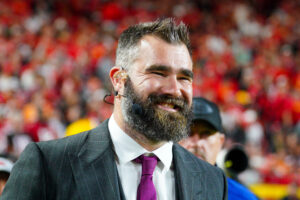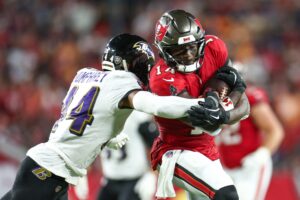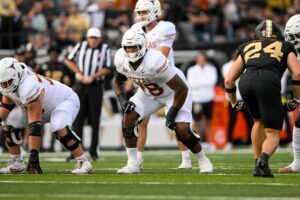Every year the path to victory does not begin in training camp, nor draft day, and not even free-agency on March 14. Rather, the drive to Super Bowl 53 begins before the final plays of the 2017 season are physically concluded. Scouts, general managers, and personnel departments formulate plans and never rest on the laurels of success in the moment. The NFL is eternally a forward battle of getting better or dying now. While that may seem pessimistic, there really is only one winner at the end of the year.
Driving the pessimism even further is the fact that some teams must be virtuously honest with themselves if they fundamentally want to improve for the next season. One of those teams in the 2018 off-season is the Kansas City Chiefs – a team with options at several positions and growing needs due to age at others. There was a holistic lack of consistency on defense, and the very intrinsic structure of the system fell apart, Bob Sutton or not. With Brett Veach and Andy Reid coordinating their first off-season together as a general manager-head coach duo, the Kansas City Chiefs 2018 off-season is one which will determine the long-term scheme, outlook, and hope for the team.
Kansas City Chiefs 2018 Off-Season Options (Defense)
Since the Chiefs boast a plethora of options, both in the NFL Draft and free agency, the following is a quick summation of each position. As the off-season shapes up, be on the watch for more specific articles on the positions Reid and Veach put an emphasis on. Detailed draft profiles will be included as well.
The Chiefs currently have picks 54, 86, 118, and 182 in the 2018 NFL Draft. This does limit them to drafting very specific needs and not frivolously reaching for players. They are also $14 million over the cap, which will force them to move assets.
This article will focus on the defense, whereas the offensive off-season options are addressed at the following link.
The defense is broken down into positions not based on roster slot, but conceptual use. Unless the Chiefs move away from the 3-4, their assets are spread differently than other teams, which is the reason for the following breakdown.
Defensive Line
After Dontari Poe left for the Atlanta Falcons last season, there was a wide swath of inconsistency left in his wake. Roy Miller was arrested and cut halfway through the season. Bennie Logan played at replacement level or below. Chris Jones was hurt and Allen Bailey was not special. Jarvis Jenkins took 13 weeks to become a dominating force. The upside is once Jones was healthy, and Jenkins found some semblance of consistency, the interior was point and tangent to defensive success.
After giving up the second most explosive runs in the NFL, the Chiefs need to take a hard-core look at their interior defensive line. Without getting a push, the linebackers spent more time running into their own lineman and playing inexcusably confused on their own accord.
Assuming the Chiefs move money around elsewhere (trade Alex Smith) and do not sign a wide receiver, free agency could see a big splash with a big man. Logan was only on a one-year deal, and the preference would be to let him move on. Bringing Poe back is viable, but the Falcons may sign him to a long-term deal.
Veteran options are Kyle Williams or Haloti Ngata, both whom would demand in the range of $5-8 million per year depending on how many years the contract is. A four-year, $20-24 million option would be enthralling to acquire either. Clinton McDonald would be a less productive option, but a less costly option at $3-4 million per year.
If the Chiefs want to splash and cause a shock wave, they could go after Sheldon Richardson, Star Lotulelei, or Dominique Easley on a multi-year, $10 million (starting negotiation there) baseline deal. The cost is high and breathtaking but these three have the skill set to revitalize and solidify the interior for years. Such a signing would additionally free them to draft elsewhere.
The market richness could easily end before free agency even begins. All six names could be brought back to their original teams. That leaves the Chiefs to acquire a Cedric Thornton, Jordan Hill, or Justin Ellis on a minimum deal and put their long-term hope in a rookie.
While names such as Vita Vea and Maurice Hurst are floating around, they will rise to top-20 level again due to their versatility. The Chiefs would be getting a gift if either falls to 54.
Alabama is producing two big nose tackles who can stuff the middle in Da’Ron Payne and Da’Shawn Hand. While Hand is built more for range, both are more versatile than Logan, and possess agility with strength. The pace of the draft will most likely dictate the flow of players taken, implicating Payne and Hand could fall anywhere from round one to day two.
Harrison Phillips of Stanford had 103 tackles in his senior season, producing at a high level stopping runs. He is less agile off the line, which would suffice the Logan role instead of a versatile complement to Jones. He currently projects at 54 or just lower – meaning the Chiefs could trade 54, and still acquire him.
A late Senior Bowl candidate to watch will be Division II superstar Nathan Shepherd from Fort Hays State. He has a dominant wingspan and can fit into the Chiefs defense as a project over the next two seasons. Standing at 6’5” and 300 pounds, the numbers align, but he needs to be competitive with fast-twitch at the Senior Bowl to jump on draft boards.
Edge Rusher
Justin Houston, Tamba Hali, and Dee Ford are all still on the roster. The pass rush, which was ninth worst at a mere 31 sacks, does not have a paper problem, rather an effort problem. Houston comes in at a $20 million cap hit and an underwhelming disappearing act throughout 2017. Hali is aging and injured, but still hits a $9.4 million cap hit. Ford sits at $8.7 million but was also hurt and unproductive.
The conversation around the edge rushers becomes a question of salary allocation and the Chiefs identity. With 21 percent of the salary tied into the breadth of pass rush units and a lack of productivity, 2018 needs to answer the question if Ford and Houston can be trusted moving forward.
Do not expect a large allocation of money or draft picks coming to the edge rush area, despite the desperate need for improvement. The players are there, and Reid has typically trusted his players opposed to moving on.
If anything happens, Cassius Marsh may find his way to the Chiefs on a minimum deal. Marsh is a specialized pass rusher who has been around the NFL. Devon Kennard, Marquis Flowers, or Lamarr Houston may be other options for a rotational piece, with Flowers being the most expensive.
High round draft picks for edge rusher would be Sam Hubbard of Ohio State or Dorance Armstrong from Kansas. Hubbard has a deep toolbox, but was hit and miss, implicating he needs more practice. However, a year rotating with Hali could do the trick. Armstrong has an equally impressive skill set, but was one of the only good Kansas players, meaning he was double-teamed and swallowed consistently in his senior year. After landing 10 sacks in 2016, he only managed two in 2017.
A deep prospect to watch is Marquis Haynes from Ole Miss. He had 7.5 sacks and 45 tackles but may not have the sufficient intangibles and toolbox to be a true outside linebacker. Therefore, he could go to the Chiefs late on day three and subsequently trained as a pure pass rusher.
Interior Linebacker
Production from the law firm of Wilson, Ragland, and Johnson was less than stellar, and often, a courtroom comedy. Reggie Ragland was still learning the system for half of the year and thus has upside for continued improvement. Ragland is the highest upside linebacker for the Chiefs due to the process.
Meanwhile, Derrick Johnson was clearly slower on the field due to his age and multiple injuries. The lack of consistency from Johnson was disappointing. However, he can still pop quarterbacks and running backs, as seen in his destruction of Marcus Mariota.
Highlights are highlights prominently because they are anomalies, and Johnson’s highlights were anomalies. Standing at a $10 million cap hit, Johnson may be a cap casualty if his contract is not restructured. The level of play between Johnson and Ragland became increasingly nominal.
Ramik Wilson is set to be a free-agent and should be re-signed for the right price. Wilson is a rotational player by definition and has limitations. He may never amount to more than a system player who can suffice with help.
With Reid’s propensity to go after in-system players, Ragland set as the future, and Johnson probably getting a re-structured deal, the hinge point here is what Wilson does. The draft needs elsewhere dictate Wilson gets re-signed. In the NFL, the Chiefs will probably just land another player of his equal value.
While this is more a dream than a defined need, Nick DeLuca from North Dakota State would be a fun draftee. DeLuca is the defensive persona of fellow Bison alum Carson Wentz. Despite playing opposite sides of the ball, both are defined leaders, rough football players, and carry the strength of their position equally. There is an innate part of his strength and mentality that could make DeLuca a fantastic inside linebacker in the NFL. He does not possess powerful range, but incredible straightforward speed and power makes him a fit for the Chiefs linebacker corps.
Cornerback
The discussion of cornerback is where the discussion turns into a diatribe. The Chiefs have yet to develop a consistent, valuable, second cornerback across from Marcus Peters. Darrelle Revis is locked up for the season at $4.5 million and may be the best answer instead of going to free agency. If the Chiefs do go that route and sign a solid number two, they’ll more than likely cut Revis.
Steven Nelson and Eric Murray are the other two cornerbacks on the roster who can be viable and said viability should be read as a giant question mark. The lack of consistency has been often covered up by the pass rush, which is why both units falling to tragic levels in the same season was symbiotic.
Part of the moves at cornerback will be intrinsic to the processing of Johnson and Smith. Freeing up money could open room for E.J. Gaines who will be a free agent after a season with the Buffalo Bills. Gaines fills the role with consistency. He will not be egregiously burned, and with Eric Berry returning, makes a holistic secondary.
After Gaines, the market becomes rich and expensive. Kyle Fuller, Malcolm Butler, D.J. Hayden, Prince Amukamara, and Trumaine Johnson will all be out of the Chiefs price range. Hayden is the only one who may slip through the cracks, but he has big play, inconsistency problems. The other cornerbacks on the market do not necessarily fit the Chiefs model and would be 34 or older. Signing one of them would be equal to having Revis.
Thus, pick 54 and cornerbacks should be the main topic. Acquiring a top defensive lineman, wide receiver, or pass rusher slows the bleeding. Solidifying a lockdown corner who does need to rely on a pass rush to succeed makes the Chiefs secondary stops the bleeding.
Mike Hughes from Central Florida is intriguing due to his versatility as a nickel and traditional corner, as well as a special teams returner. His speed and pop power make him impressive on the outside, a wonderful complement to Peters. Receivers will be insistently blanketed by Hughes, which does implicate the pedantic pass interference penalties. The stickiness to receivers is worth the upside; few receivers will be able to use speed to break away.
Jaire Alexander from Louisville is another prominent, tough cornerback who can play in multiple roles. His mentality and toughness complement Peters, just without the overt verbosity. Alexander has a propensity to mess with receivers in technique downfield, which makes him a perfect candidate for the Chiefs receivers. He will redirect with a sleight of hand, meaning he can last more than three seconds in a route. Each route is a war with Alexander.
Should Hughes and Alexander both rise (there could be a quick run on cornerbacks), Anthony Averett from Ohio State could see a prominent fall. He will sit out the Senior Bowl due to an ankle injury. He is a zone coverage cornerback who may not elicit the physicality the Chiefs own, but he can bring floaty range into the second role. He has foresight into where passes will go and has a focused eye line to the ball. He may not have the biggest upside, but is a safe pick who can join Revis, grow, and take over in year two.
Safety
The Chiefs safeties had problems last year, but with Berry out, any team would have trouble. Ron Parker took leadership at times, but other times missed Berry. Daniel Sorensen has huge limitations and was disappointing as a starter – he is a mediocre backup. Leon McQuay was drafted last year and saw progressive playing time against the Denver Broncos in the finale. Point is, the Chiefs are set at safety and will continue to let McQuay grow in the system.
Main Image:






